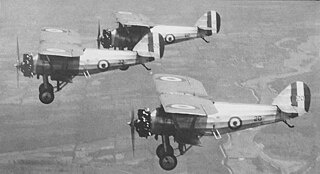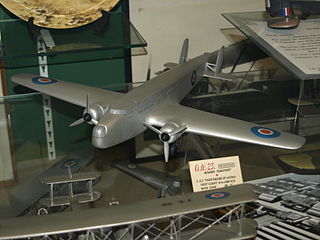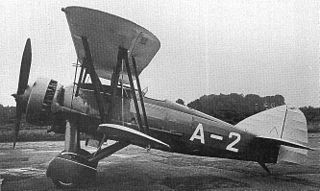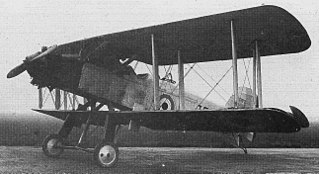| Awana | |
|---|---|
 | |
| Role | Military transport biplane |
| Manufacturer | Armstrong Whitworth |
| First flight | 28 June 1923 |
| Number built | 2 |
The Armstrong Whitworth Awana was a British prototype troop-transport aircraft built to meet a 1920 Air Ministry requirement.
| Awana | |
|---|---|
 | |
| Role | Military transport biplane |
| Manufacturer | Armstrong Whitworth |
| First flight | 28 June 1923 |
| Number built | 2 |
The Armstrong Whitworth Awana was a British prototype troop-transport aircraft built to meet a 1920 Air Ministry requirement.
The Awana was designed in response to Air Ministry Specification 5/20 for a twin-engined Troop Carrying Aeroplane, able to carry 25 fully equipped troops for a distance of 400 miles. Any design was to be capable of landing on rough terrain, other requirements being folding wings and the ability to fly on one engine. [1]
One of the largest landplanes of its time, [2] it was a large, twin-engine four-bay staggered biplane with a box-like fuselage, and a three-rudder, biplane tail. The pilot and navigator sat in open cockpits atop the nose, while the 25 troops it was to carry entered through a hatch in the floor and sat in two rows of "bus"-style seats with a centre aisle. It was of composite construction, with a tubular-steel-framed fuselage and wooden wings incorporating substantial hinges to allow them to be folded for storage. The Napier Lion engines were supported on tubular-steel supports between the wings and housed in streamlined cowlings with retractable radiators on the underside. The three cylindrical main petrol tanks were slung under the floor in an aluminium fairing, and fed fuel via windmill-driven pumps to header tanks on the underside of the upper wing. [3]
Two prototypes were ordered by the Air Ministry on 27 June 1921, and the first prototype, serial number J6897, first flew on 28 June 1923. Evaluated at Martlesham Heath, control during landing was found to be poor, and the structure overall too flimsy. The second prototype addressed some of these concerns, but the Vickers Victoria was selected for production instead. [4]
Data from Armstrong Whitworth Aircraft since 1913 [5]
General characteristics
Performance
Aircraft of comparable role, configuration, and era

The Armstrong Whitworth A.W.38 Whitley was one of three British twin-engined, front line bomber types that were in service with the Royal Air Force (RAF) at the outbreak of the Second World War. Alongside the Vickers Wellington and the Handley Page Hampden, the Whitley was developed during the mid-1930s according to Air Ministry Specification B.3/34, which it was subsequently selected to meet. In 1937, the Whitley formally entered into RAF squadron service; it was the first of the three medium bombers to be introduced.

The Armstrong Whitworth A.W.41 Albemarle was a twin-engine transport aircraft developed by the British aircraft manufacturer Armstrong Whitworth and primarily produced by A.W. Hawksley Ltd, a subsidiary of the Gloster Aircraft Company. It was one of many aircraft which entered service with the Royal Air Force (RAF) during the Second World War.

The Armstrong Whitworth Siskin was a biplane single-seat fighter aircraft developed and produced by the British aircraft manufacturer Armstrong Whitworth Aircraft. It was also the first all-metal fighter to be operated by the Royal Air Force (RAF), as well as being one of the first new fighters to enter service following the end of the First World War.
Sir W. G. Armstrong Whitworth Aircraft Company, or Armstrong Whitworth Aircraft, was a British aircraft manufacturer.

The Armstrong Whitworth Argosy was a three-engine biplane airliner designed and produced by the British aircraft manufacturer Armstrong Whitworth Aircraft. It was the company's first airliner.

The Vickers Type 56 Victoria was a British biplane freighter and troop transport aircraft used by the Royal Air Force. The Victoria flew for the first time in 1922 and was selected for production over the Armstrong Whitworth Awana.

The Vickers Virginia was a biplane heavy bomber of the British Royal Air Force, developed from the Vickers Vimy.

The Armstrong Whitworth A.W.23 was a prototype bomber/transport aircraft produced to specification C.26/31 for the British Air Ministry by Armstrong Whitworth Aircraft. While it was not selected to meet this specification, it did form the basis of the later Armstrong Whitworth Whitley aircraft.

The Armstrong Whitworth AW.15 Atalanta was a four-engine airliner designed and produced by the British aircraft manufacturer Sir W.G. Armstrong Whitworth Aircraft Limited at Coventry.

The Armstrong Whitworth A.W.35 Scimitar was a British single-engine biplane fighter aircraft designed and built by Armstrong Whitworth Aircraft. Four Scimitars were produced for the Norwegian Army Air Service and were delivered in 1936.

The Armstrong Whitworth A.W.16 was a British single-engine biplane fighter aircraft designed and built by Armstrong Whitworth Aircraft. A number were sold to the Chinese Kwangsi Air Force.

The Armstrong Whitworth Wolf was a British two-seat reconnaissance aircraft ordered by the Royal Air Force in 1923.

The Armstrong Whitworth A.W.14 Starling was a British single-engine biplane fighter developed for the Royal Air Force in the 1920s. The plane was an unsuccessful model, with the Bristol Bulldog being selected instead.

The Vickers Vixen was a British general-purpose biplane of the 1920s. Designed and developed by Vickers in a number of variants, with 18 Vixen Mark V sold to Chile. A prototype of a version with metal wings was built as the Vickers Vivid. The Vixen also formed the basis of the closely related Venture and Valparaiso aircraft, which were also built and sold in small numbers in the 1920s

The Armstrong Whitworth AW.55 Apollo was a 1940s British four-engine turboprop airliner built by Armstrong Whitworth at Baginton. The aircraft was in competition with the Vickers Viscount but was beset with engine problems and only two were built.
The Armstrong Whitworth Armadillo was a British single-seat biplane fighter aircraft built by Armstrong Whitworth.

The Armstrong Whitworth A.W.19 was a two/three-seat single-engine biplane, built as a general-purpose military aircraft in the mid-1930s. A newer, monoplane aircraft was preferred and only one A.W.19 was built.

The Vickers Type 253 was a single-engined two-seat biplane general-purpose military machine built to a 1930 government specification. It won a production contract, but this was transferred to the same company's monoplane equivalent, the Wellesley. Only one Type 253 was built.
The Armstrong Whitworth F.K.5 and F.K.6 were experimental triplanes built as escort fighters by Armstrong Whitworth during the First World War. They carried two gunners in nacelles mounted on the centre wing. One example of each type was built, with no further development or production following.
The Blackburn F3 was a British single-engined fighter aircraft produced in response to Air Ministry Specification F.7/30.
| Wikimedia Commons has media related to Armstrong Whitworth Awana . |